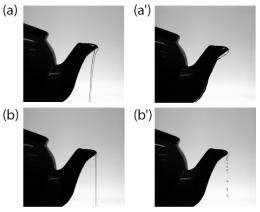November 2, 2009 weblog
Solving Teapot Effect

(PhysOrg.com) -- A team of scientists from France have worked out why teapots dribble at low flow rates, and how to stop them. The effect is called the "teapot effect", and solving it could finally put an end to tea stains from dribbling teapots.
Previous research on the teapot effect has found that at higher flow rates the layer of fluid closest to the surface of the teapot spout becomes detached from it and the fluid flows smoothly. At low flow rates there is flow separation in which the boundary layer reattaches to the surface instead of flowing over it, causing the flow to stop and start; in other words to dribble. A number of factors are known to affect how much the teapot dribbles, such as the diameter of the spout, the teapot material, and speed of flow, but until now no one has come up with a scientific solution.
Fluid dynamics experts C. Duez, C. Ybert, C. Clanet, and L. Bocquet, from the University of Lyon have solved the problem by identifying the fundamental cause of dribbling: a "hydro-capillary" effect that keeps the liquid in contact with the surface as it leaves the spout. The other factors -- "wettability" of the teapot material, velocity of the flow, and curvature of the lip -- determine the strength of this effect.
The authors suggest that one way to avoid dribbling is to make the lip of the spout as thin as possible (as in metal teapots, which rarely dribble), while the ultimate way to instantly stop dribbling and end the teapot effect for good is to use a thin, sharp-ended spout and coat the lip with one of the latest super-hydrophobic materials. These materials strongly repel water and prevent the tea from clinging to the teapot material, which adds weight to the old idea that smearing butter on the spout stops dribbling.
Duez and his colleagues also suggest that some super-hydrophobic materials can be controlled electronically, and while it is hard to see why anyone would want a teapot with a dribble switch, there may be applications in controlling fluid flow in microfluidic devices.
The research paper is published online in arXiv.org.
More information: Beating the teapot effect, C. Duez, C. Ybert, C. Clanet, L. Bocquet, arXiv:0910.3306
© 2009 PhysOrg.com


















